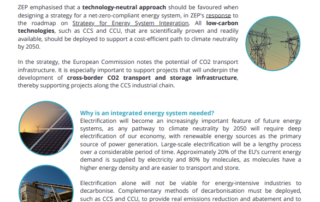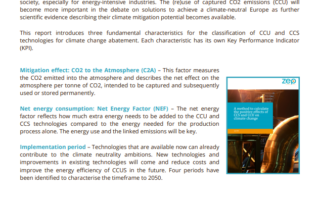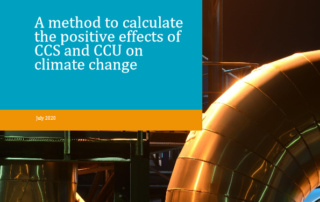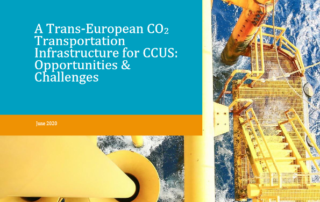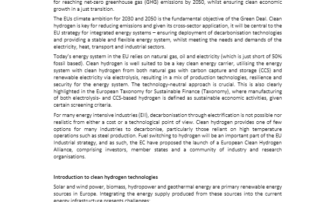Infographic – European Strategy for Energy System Integration
This infographic summarises ZEP's response to the 'Roadmap on Strategy for Energy System Integration'. ZEP supports the EU’s objective of climate neutrality by 2050. While designing a strategy for a net-zero compliant energy system, ZEP believes that a technology-neutral approach should be privileged. All low-carbon technologies, such as CCS and CCU, that are scientifically proven and readily available, should be deployed to support a cost-efficient trajectory to climate neutrality.
Infographic – A Trans-European CO2 Transportation Infrastructure for CCUS: Opportunities & Challenges
This infographic summarises the ZEP report 'A Trans-European CO2 Transportation Infrastructure for CCUS: Opportunities & Challenges'. This report looks at the challenges and opportunities for CO2 transport in Europe, including pipelines and other modes of transport. It provides an overview of CO2 transportation, particularly in industrial clusters, and highlights the importance of developing dedicated business models, as well as enabling policy framework, for CO2 transportation. This report is particularly relevant in the context of the European Green Deal, as CO2 infrastructure is crucial to deliver large-scale decarbonisation across industry and energy sectors, which will be necessary to achieve climate-neutrality.
Infographic – Europe needs a definition of Carbon Dioxide Removal
This infographic summarises ZEP report 'Europe needs a definition of Carbon Dioxide Removal'. This report provides clear and concise definitions of commonly used terms around Carbon Dioxide Removal, to give an overview of existing technologies and their potential for emissions reduction, to identify some examples of European industrial plants that could go carbon negative and to advocate for European CO2 transport and storage infrastructure, a real enabler for large-scale carbon dioxide removals.
Infographic – A method to calculate the positive effects of CCS and CCU on climate change
This infographic summarises ZEP report 'A method to calculate the positive effects of CCS and CCU on climate change'. The value of CCS and CCU projects to climate change mitigation is crucial, however, how to assess the added value, to be more exact, is complex. There are many factors that could play a major role, such as which boundary conditions and assumptions to use. With this report, we are introducing three fundamental characteristics for the classification of technologies for climate change abatement of CCU and CCS projects: mitigation effect, net energy consumption, and implementation period. This report also includes examples showing the value of this concept.
A method to calculate the positive effects of CCS and CCU on climate change
The value of CCS and CCU projects to climate change mitigation is crucial, however, how to assess the added value, to be more exact, is complex. There are many factors that could play a major role, such as which boundary conditions and assumptions to use. With this report, we are introducing three fundamental characteristics for the classification of technologies for climate change abatement of CCU and CCS projects: mitigation effect, net energy consumption, and implementation period. This report also includes examples showing the value of this concept.
Europe needs a definition of Carbon Dioxide Removal
This report provides clear and concise definitions of commonly used terms around Carbon Dioxide Removal, to give an overview of existing technologies and their potential for emissions reduction, to identify some examples of European industrial plants that could go carbon negative and to advocate for European CO2 transport and storage infrastructure, a real enabler for large-scale carbon dioxide removals.
A Trans-European CO2 Transportation Infrastructure for CCUS: Opportunities & Challenges
This report looks at the challenges and opportunities for CO2 transport in Europe, including pipelines and other modes of transport. It provides an overview of CO2 transportation, particularly in industrial clusters, and highlights the importance of developing dedicated business models, as well as enabling policy framework, for CO2 transportation. This report is particularly relevant in the context of the European Green Deal, as CO2 infrastructure is crucial to deliver large-scale decarbonisation across industry and energy sectors, which will be necessary to achieve climate-neutrality.
Report outline – CCS enables early and cost-efficient clean hydrogen at scale
This 5-page report outline focuses on how to kick-start a European clean hydrogen economy. A more extensive report on this subject is planned for autumn 2020. This paper aims at providing input on how the European Commission can enable a European clean hydrogen market with clean hydrogen from natural gas with CCS. The extended version of the report will expand on the technological matters of clean hydrogen production and hydrogen infrastructure, and will indicate what the necessary policy framework could look like.

